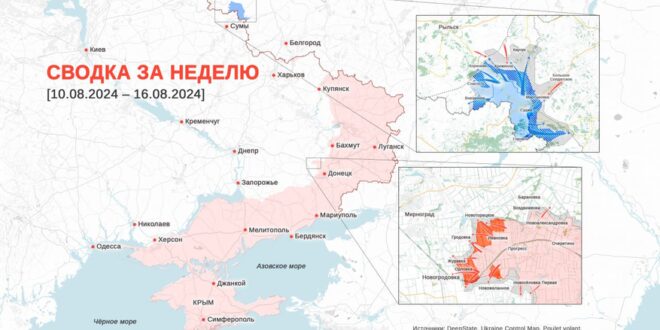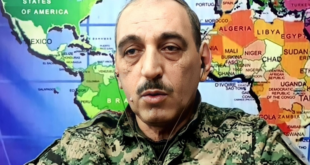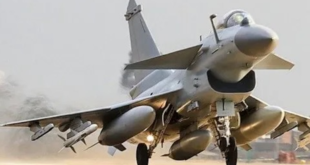In today’s summary:
- The Ukrainian Armed Forces are expanding their foothold in the Kursk region, claiming control over 1,150 sq. km of territory and 82 populated areas
- In the occupied part of the Kursk region, a Ukrainian military commandant’s office was created, headed by a general named Moskalov
- The Russian command has not yet transferred significant forces from Ukrainian territory to the Kursk direction
- The Insider has published an article about the interim results of the Kursk operation of the Ukrainian Armed Forces and scenarios for further developments
- The Russian Armed Forces’ offensive in Donbass is not losing momentum: Pokrovsk is less than 15 km away, fighting is taking place in the residential areas of Toretsk
- The scale of Ukrainian missile and drone strikes in a week has significantly exceeded Russian raids
- Up to 2,000 Russian servicemen, including hundreds of conscripts, could have been captured in the Kursk region
- US Considers Transferring JASSM Long-Range Cruise Missiles to Ukrainian F-16 Fighters
The situation at the front
Over the past week, the Ukrainian Armed Forces continued to expand their bridgehead in the Kursk region , although not nearly as rapidly as in the first days of the operation. In particular, they managed to completely occupy the city of Sudzha , significantly advance to the southeast of the city in the direction of the administrative border with the Belgorod region , gain a foothold near the district center of Korenevo , and reach the border of the Glushkovsky district from the west , taking the village of Vnezapnoye . Now the Ukrainian command is trying to cut off this border region from the rest of the region, for which purpose one of the bridges across the Seim River has been destroyed .
Z-channels describe the Ukrainian tactic as inserting mobile groups in armored fighting vehicles between disparate and poorly coordinated Russian units and then cutting them off from the main forces. Apparently, this really works – new footage of large groups of Russian prisoners of war continues to arrive from the Kursk region (the largest this week counted 102 people), and among the Ukrainian trophies was a modern T-90M tank .
However, such tactics are associated with significant risks – during the week it became known about the defeat of at least two Ukrainian armored groups ( 1 , 2 ). Also unsuccessful were attempts to break through to the neighboring Belgorod region in the area of the Kolotilovka border checkpoint , from where fighters of the Russian 155th Marine Brigade published a video with the head of a Ukrainian soldier impaled on a pike and threats against the Ukrainian Armed Forces fighters.
The Russian side, in turn, is setting up rear lines of defense to contain the further advance of the Ukrainian Armed Forces (for which they are recruiting laborers using online ads). Various reserves are being transferred to the Kursk region , including experienced UAV operators . In addition, conscripts are being sent to the region from all over Russia , and “ refuseniks ” from the Leningrad region . Nevertheless, according to CNN, the command of the Russian Armed Forces has not yet withdrawn significant forces from the fronts in Ukraine. The Ukrainian Armed Forces, in turn, are also bringing in reinforcements, including paratroopers from the 95th Air Assault Brigade and detachments of Ukrainian prisoners .
The Insider has published an article about the interim results of the Kursk operation of the Ukrainian Armed Forces and possible further developments. The main results can be considered the next overcoming of the “red lines” concerning the use of Western equipment on the internationally recognized territory of Russia, as well as the dilemma facing the Russian leadership, which will need to create a group of up to 30,000 people to displace the enemy from the Kursk region .
Despite the transfer of individual units of the former ” DPR ” and ” LPR ” , UAV operators , and regular units of Russian infantry from the Donetsk region , the offensive of the Russian Armed Forces in the Pokrovsk direction is not slowing down. In this direction, Russian forces managed to occupy several settlements at once ( 1 , 2 , 3 , 4 ) and approach Pokrovsk (before 2016 – Krasnoarmeysk ) to a distance of less than 15 km . The offensive continues through traditional ” meat assaults “.
The advance of the Russian Armed Forces in the area of high-rise buildings in the east of Toretsk (until 2016 – Dzerzhinsk ) and successes on the eastern face of the Ugledar salient , where the Russians managed to cross the Ugledar – Maryinka highway and approach Selidovo at a distance of less than 6 km, as well as occupy a third of Konstantinovka , were also noted . Ukrainian military personnel continue to complain about the lack of personnel: for example, near Krasnogorovka , according to one of the Ukrainian Armed Forces commanders, the enemy has a five-fold superiority in manpower, and reinforcements from mobilization make up only 20% of Ukrainian losses.
Analyst Michael Cruickshank cites satellite images that clearly show the front line in Ukraine, resembling a deep scar, across fields taken out of economic use. The experience of France, where more than 100 years after the end of the First World War, the sites of the battles remain a “red zone” unsuitable for human activity, suggests that it may take a very long time to restore these territories.
Mutual shelling and sabotage
The Ukrainian Air Force Command reported repelling several nighttime missile and drone strikes over the past week. According to the Ukrainian military:
On the night of August 11, 54 of the 57 launched Shaheeds were shot down , and four North Korean KN-23 ballistic missiles were also launched, with the explosion of one of them in the Kiev region killing a father and son;
On the night of August 13, 30 of the 38 Shaheds were shot down, and it was also reported that two ballistic missiles were launched – one of them, which fell on residential buildings in the Bogodukhov district of the Kharkiv region , also turned out to be a North Korean KN-23;
On the night of August 14, 17 of 23 Shaheds were shot down, and two Kh-59/Kh-69 missiles were launched (no interception was reported). The UAV raid damaged a power facility in the northern region, and power supply was temporarily interrupted in certain areas of the Chernihiv region ;
on the night of August 15, all 29 Shaheds were intercepted, and three Kh-59 missiles were also launched (they were not intercepted);
On the night of August 16, three Shaheds and two UAVs of an unspecified type were shot down, and the launch of three Iskander ballistic missiles was also noted .
Also during the week, it became known about Russian strikes on the following military and civilian targets:
on the Su-27 aircraft at the Mirgorod airfield in the Poltava region and on the MiG-29 at the Aviatorskoye airfield in the Dnepropetrovsk region ;
on the port civilian infrastructure of Odessa (three people were injured);
on the S-125 air defense missile system and the HIMARS MLRS ( 1 , 2 ) in the Sumy region .
The authorities of Donetsk ( 1 , 2 , 3 ), Kherson ( 1 , 2 , 3 ) and Kharkiv regions ( 1 , 2 , 3 ) also reported deaths and injuries among civilians as a result of shelling . In Sumy region , which borders Kursk region , 185 border settlements are subject to priority evacuation due to Russian shelling, the Ukrainian Ministry of Internal Affairs reported .
If we are to believe the data of the Russian Defense Ministry, the scale of Ukrainian drone raids exceeds the figures for similar Russian strikes on Ukraine. According to the agency, over the course of a week over the territory of Russia and occupied Crimea :
On the night of August 10, 32 aircraft-type UAVs were intercepted;
On the night of August 11, 35 UAVs and 4 Tochka-U ballistic missiles were destroyed;
On the night of August 12, 18 UAVs were intercepted;
on the night of August 13 – 14 UAVs;
On the night of August 14, 117 UAVs and 4 tactical missiles were destroyed; according to Ukrainian data, four military airfields in the Voronezh , Kursk and Nizhny Novgorod regions were hit , at two of them some damage to infrastructure is visible on satellite images ( 1 , 2 );
on the night of August 15, one UAV was destroyed;
On the night of August 16, five UAVs, two unmanned aerial vehicles and 12 ATACMS missiles were destroyed . The strikes were probably aimed at a bridge and crossing , as well as the positions of the Pantsir-S1 air defense missile and gun system in the Kerch area in occupied Crimea , at least one person was injured.
Thus, according to the Ukrainian military, in just one week, 152 UAVs and 14 missiles were used in night raids on Ukraine, while according to the Russian military, at least 222 drones, 20 missiles and two unmanned aerial vehicles were used in strikes on Russia and Crimea (at the same time, the Russian Defense Ministry does not report on those drones and missiles that were not intercepted).
Also during the week, it became known about Ukrainian strikes on the following targets:
on the coast guard boat in Crimea ;
on a gas platform in the Black Sea where Russian military personnel were allegedly stationed and GPS spoofing equipment was also deployed;
according to the 39N6 Kasta-2E2 radar in the occupied part of the Zaporizhia region ;
on the Pantsir-S1 anti-aircraft missile and gun system on the occupied left bank of the Kherson region .
Russian authorities and occupation administrations reported casualties and deaths as a result of shelling in the “LPR , ” the “DPR” (where two people were killed and 11 injured as a result of a strike on the Galaktika shopping center in Donetsk ) and the Belgorod region ( 1 , 2 ), where a federal state of emergency was declared and entry to five populated areas was closed due to shelling and attacks by the Ukrainian Armed Forces .
Ukrainian authorities have accused Russia of deliberately setting fire to a cooling tower at the Zaporizhia NPP . Local “authorities”, in turn, said it was an attack by a Ukrainian drone. The IAEA noted that the incident did not increase the radiation hazard. Dmitry Gorchakov, an adviser to the international environmental organization Bellona, gave the same assessment , since the cooling towers are currently not being used in any way, all reactors are in a state of cold shutdown, and the fire itself occurred 1.5 km from the nearest power unit.
Losses
According to reports from Z-channels close to the Russian Aerospace Forces , on August 10, a Ka-52 helicopter was shot down with a MANPADS while performing combat missions, probably in the Kursk direction . “Military Informant”, in turn, draws attention to the obituary of a Ukrainian MiG-29 pilot who was shot down on August 12, possibly also while performing missions in support of the Kursk offensive of the Ukrainian Armed Forces.
In the Kursk region, strikes by Lancets on Ukrainian armored vehicles are increasingly being reported , including, allegedly , on a British Challenger 2 tank. At the same time, an incident was reported with friendly fire from a Russian helicopter on a column of the Russian Armed Forces, which was probably mistaken for a Ukrainian sabotage and reconnaissance group , as a result of which an Msta-S self-propelled gun was destroyed . Ukrainian equipment is also being captured by the enemy as trophies – in particular, Z-channels have been broadcasting footage of a Russian soldier from the 810th Marine Brigade, who emotionally and using foul language rejoices at the capture of an American armored vehicle HMMWV.
Researcher Naalsio, who calculates the losses of Russian and Ukrainian equipment based on visual evidence, presented data on losses in the Kursk direction . According to his information, confirmed losses of the Ukrainian Armed Forces in the Kursk and Sumy regions in the period from August 6 to 15 amounted to 51 units of equipment, while the Russian Armed Forces lost 27.
It is worth noting that the Ukrainian military almost never publishes footage from UAVs from the Kursk region , where the destruction of Russian equipment would be recorded, but it is known that drones are used there (for example, one of them hit the car of “war correspondent” Yevgeny Poddubny), so in reality the losses of the Russian Armed Forces may be significantly higher.
As of August 13, at least 265 Russian soldiers had been captured in the Kursk region, according to a count based on publicly available photos and videos. Unconfirmed estimates put the total number at between 1,000 and 2,000 . According to Ukrainian ombudsman Dmitry Lubinets, this forced Russia to initiate prisoner exchange talks for the first time, which had so far been initiated by the Ukrainian side. Hundreds of conscripts are likely among these prisoners — the Astra publication confirmed the identities of 42 conscripts from the 488th Motorized Rifle Regiment alone who have gone missing in the Kursk region since the start of the operation.
Tatarigami_UA writes that the average age of those killed on the Russian side has increased by 7 years since the start of the war — from 30.2 years at the beginning of 2022 to 37.8 years by July 2024. The Frontelligence Insight analytical group he founded came to this conclusion based on an analysis of more than 23 thousand obituaries on social networks. According to the analyst, the “aging” of the Russian military means their lower combat readiness and an increase in losses from chronic diseases.
In the first seven months of 2024, Russian courts received 5,204 criminal cases of unauthorized abandonment of a military unit, which is more than for the entire 2023 (5,096), Mediazona found out . The publication emphasizes that the total number of cases against deserters that did not reach court may be significantly higher. Earlier it became known that in the first half of 2024, almost 30 thousand cases were opened in Ukraine on similar charges, which also exceeded the figures for the entire 2023.
Weapons and military equipment
This week, it became known about another US military aid package to Ukraine within the PDA in the amount of $125 million. It included, in particular, ammunition for air defense , artillery and HIMARS MLRS, as well as anti-tank weapons, radars and medical vehicles based on the HMMWV. In turn, Lithuania announced the imminent delivery, among other things, of 14 M113 armored personnel carriers and short-range air defense systems, Latvia – about the transfer of another batch of 500 drones within the framework of the “unmanned coalition”, and the German concern Rheinmetall – about a government order for 8 advanced surgical stations for the Armed Forces of Ukraine, which will be delivered from 2024 to 2026.
It has also emerged that the US is considering transferring JASSM long-range cruise missiles to Ukraine for launch from recently delivered F-16 fighters, and Ukraine is planning to recruit retired Western pilots to fly these aircraft, as training of Ukrainian crews is progressing slowly.
In addition, Sweden is considering sending military advisers to Ukraine to organize defense procurement and study the experience of using and operating Swedish equipment, and Germany has published a list of military supplies that are planned to be carried out by the end of 2024 – it includes, in particular, 30 Leopard 1A5 tanks, 400 MRAP armored vehicles , 12 PzH 2000 self-propelled guns and four Slovak-made Zuzana 2 wheeled self-propelled guns, as well as two batteries of IRIS-T SLM and IRIS-T SLS air defense systems.
In turn, the Ukrainian foundation “Turn Alive” handed over to the troops the first batch of interceptor drones for hunting Russian reconnaissance aircraft-type drones, and the “Steel Front” initiative of oligarch Rinat Akhmetov reported the dispatch of 12 FV432 armored personnel carriers and two FV434 armored recovery vehicles purchased in the UK to the 3rd Separate Air Assault Brigade .
Meanwhile, Russian defense industry enterprises have delivered a new batch of Su-30SM2 fighters to the Russian Defense Ministry , which differ from the previous modification in that they do not contain sanctioned components, as well as BREM-1M armored repair and recovery vehicles , although without automatic coupling devices .
At the front, the Russian military uses EW -protected drones controlled via fiber optic cable and MLRS based on the “Bukhanka”, and for logistical purposes, they use a motorcycle with a trailer in the form of a plastic pallet. Meanwhile, the Ukrainian territorial defense has made an amazing “monster truck” with the personal name “Gerasim”, consisting of units from several machines at once .
 Eurasia Press & News
Eurasia Press & News




